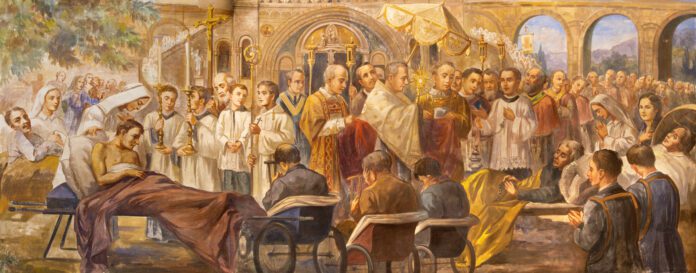In the 1990s, Buenos Aires, Argentina, had three Eucharistic miracles over the course of four years. These all took place in the Church of Santa Maria. The first happened in 1992, when two dropped consecrated hosts of the Body of Christ were placed in water to dissolve and left in the tabernacle. A week later when the bowl was examined, the hosts had turned a reddish color, seeming to indicate blood was present. Two days later, as communion was being distributed during mass, drops of blood were seen in the patens holding the hosts. The second miracle occurred in 1994, as blood was spotted running down the inside of a ciborium that was to be used for a children’s mass. The third occurred in 1996, when another dropped consecrated host was placed in water to dissolve it, but after 11 days, the host had partially turned to human flesh and had what appeared to be blood spots. In 1999, Archbishop Jorge Bergoglio (who would become Pope Frances) investigated the miracles and found that the blood was human blood with DNA. It was also type AB, matching previous eucharistic miracles and the Shroud of Turin. The flesh was examined and found to be tissue of the left ventricle of the heart. The appearance of white blood cells in the flesh indicated that the person whose flesh it was had suffered greatly. In addition, the appearance of the white blood cells themselves indicated a living sample since white blood cells die fifteen minutes post mortem.
In 2001, Chirattakonam, India at St. Mary’s Church, the Eucharist was exposed to the congregation for adoration. The pastor began to notice three dots beginning to appear on the host. Members of the congregation noticed them as well, and the pastor instructed them to keep praying. Once adoration was over, he reserved the monstrance in the tabernacle and left the parish for the week. Upon his return and preparing for mass, he noticed that the host now had what appeared to be a man’s face on it. The image was photographed and later approved by the Vatican. The host and monstrance are still reserved in India today.
The most recent confirmed miracle took place in Legnica, Poland, in 2013. On Christmas Day mass at St. Hyacinth Church, the priest dropped a consecrated Host on the ground during the distribution of Communion. He immediately placed the host in water to dissolve and reposed it in the tabernacle. On January 4, 2014, he returned to the tabernacle to see if it was dissolved.
He discovered that the host was completely intact and had what appeared to be a blood spot covering about a fifth of the host. Forensic tests were done, and it was determined that the host had fragments of heart tissue that had the appearance of being in agony. The blood was not tested, but it did contain human DNA. This evidence was enough for the Vatican to approve the miracle in 2016.
Originally published in Prime Soil Magazine | Vol. 1 No. 2
Originally presented at The 10th National Eucharistic Congress in July 2024






